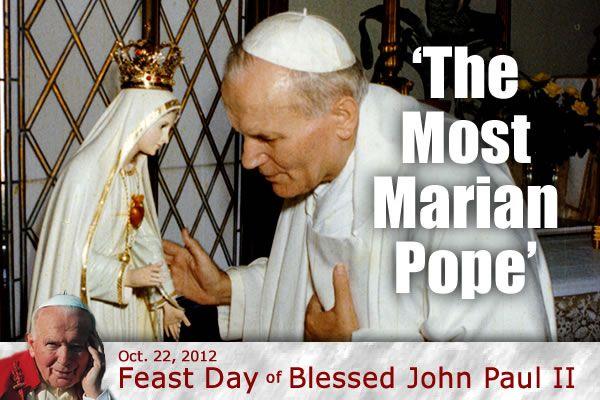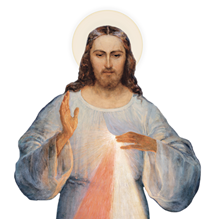
In celebration of the feast day of Blessed John Paul II on Oct. 22, we offer you the following excerpt from 33 Days to Morning Glory: A Do-It-Yourself Retreat in Preparation for Marian Consecration (Marian Press, 2012) by Fr. Michael Gaitley, MIC:
During this fourth and final full week, we'll be focusing on the example and words of another great teacher of Marian consecration: Blessed John Paul II. "The most Marian Pope," as he's been called, profoundly deepened the Church's understanding of Marian consecration. Building on the work of the Second Vatican Council, he provides us with a thoroughly biblical treatment of Marian consecration - which he also calls "entrustment" - and hones in on the idea that it's Mary's role to lead us into the mystery of Christ's redeeming love and self-consecration to the Father.
Mary's Gift of Mercy
In 1917, while World War I raged, the Blessed Virgin Mary appeared to three shepherd children in Fatima, Portugal. She told them that the war would end but if people didn't convert, a worse war would follow and Russia would spread its errors throughout the world, causing more wars, martyrs, and persecutions of the Church. To prevent this, Mary asked that the Holy Father consecrate Russia to her Immaculate Heart and for people to make five consecutive "First Saturday" communions of reparation. In the end, she said, her Immaculate Heart would triumph.
It's interesting that Mary mentioned Russia. At the time, this was cause for confusion: Russia? Holy Russia? What errors would this devoutly Christian country spread throughout the world? And how could such a poor Russia exercise so much influence? (At this point in history, the Soviet revolution was in its infancy; the communist, atheist, totalitarian regime had not yet been established.)
After Mary gave her prophesy about Russia, the children saw a vision involving a "bishop dressed in white," who they understood to be the Pope. With great distress, they saw that he would suffer much and then be shot and killed. The children described what they saw only to Church authorities, who decided not to disclose it to the public. This became known as the last "secret" of Fatima.
Now, the very first apparition of Our Lady of Fatima happened on May 13, 1917, at 5 p.m. Exactly 64 years later, May 13, 1981, at 5 p.m., a small, open-air jeep rode out into St. Peter's Square, carrying Pope John Paul II, who warmly greeted pilgrims gathered in the square. At one point, the jeep stopped so the Pope could take a little girl into his arms. After he gave her back to her jubilant parents, the jeep continued on its way through the sea of waving, cheering pilgrims. Suddenly, a gunman fired two shots at the Pope from close range. The first bullet grazed his elbow. The second struck him in the abdomen and ricocheted inside him, shredding intestines and piercing his colon. Miraculously, the bullet missed the main abdominal artery by one tenth of an inch. Had it been struck or even grazed, John Paul would have bled to death on the way to the hospital. Realizing this blessing, the Pope stated that "One hand fired, and another guided the bullet."
What hand guided the bullet? John Paul believes it was the hand of Our Lady of Fatima (the May 13th anniversary was not lost on him). In fact, after the shooting, he asked for the envelope containing the last secret of Fatima, the one about the "bishop dressed in white." Then, with Fatima much on his mind, he thought to consecrate the world to Mary's Immaculate Heart as soon as possible, and he began composing an act of entrustment, which he solemnly prayed less than a month later. Even before this, within a week of the shooting, he repeated his own personal consecration to Mary in a recorded address to the pilgrims gathered in St. Peter's Square: "To you, Mary, I repeat: Totus tuus ego sum."
On March 25, 1984, in St. Peter's Square, before the official statue of Our Lady of Fatima that had been flown in for the occasion, John Paul made a more solemn entrustment of the world to Mary's Immaculate Heart. He concluded the prayer with the following words:
Let there be revealed, once more, in the history of the world the infinite saving power of the redemption: the power of merciful Love! May it put a stop to evil! May it transform consciences! May your Immaculate Heart reveal for all the light of Hope!
After learning of the Pope's solemn entrustment, Sr. Lucia, the lone survivor of the three Fatima seers, declared that it fully satisfied Our Lady's original request. Five years later, the horrific, Soviet, totalitarian regime that had terrorized millions of people suddenly came to an end.
That victory won, the Pope didn't rest. What he once called the "century of tears" was far from over. To confront the ongoing evil and injustice in the world, he forcefully proclaimed, with growing frequency, the saving power of God's "merciful Love." His efforts to promote this message culminated in the establishment of the universal Feast of Divine Mercy Sunday in 2000 and a solemn Act of Entrustment of the world to Divine Mercy in 2002. Three years after this entrustment, the great Marian Pope, the great Mercy Pope, died on a first Saturday and the vigil of Divine Mercy Sunday. Mary had saved his life at the dawn of his pontificate so that, through him, her divine Son could lead the Church to the victory of Mercy and the triumph of her Immaculate Heart.
Today's Prayer:
Come, Holy Spirit, living in Mary...
Have mercy on us and on the whole world!
Maternal Mediation
As one of our guides to Consecration Day, Blessed John Paul II is a triple gift. Not only is he a Marian saint, like our other three guides; not only is he brilliant and thoroughly trained in theology, like de Montfort and Kolbe; but he is also a Pope. Therefore, his words carry the teaching authority of the successor of St. Peter ... and the authoritative weight of an Ecumenical Council! Well, this is true in the sense that his teachings on the Mother of God are deeply rooted in the authoritative Mariology of the Second Vatican Council. Because of this dependence on the Council, before we look to John Paul's teaching on Marian consecration, let's see what the Council has to say about Mary. ...
One can find the main Marian teachings of Vatican II in the last chapter of the Dogmatic Constitution of the Church, known by its Latin title, Lumen Gentium. The heart of these teachings has to do with what's usually called Mary's "maternal mediation." Maternal mediation basically means that Mary is our spiritual mother (hence "maternal") who assists us from heaven with her prayers and motherly care to help bring us to God (hence "mediation"). While the term "maternal" should be familiar, "mediation" may need some explaining.
A mediator is someone who stands between two people for the sake of bringing them into unity. Thus, Jesus Christ is a mediator. He is the one who, after the Fall, stands between God and fallen humanity to bring us back into communion with God. And there's only one, as St. Paul makes clear, "[T]here is one mediator between God and men, the man Jesus Christ" (1 Tim 2:5).
If there's only one mediator between God and man, and if that one mediator is Jesus Christ, then why does the Second Vatican Council describe Mary as a mediator? Because God is generous. In other words, Jesus doesn't keep his role as mediator to himself. He wants Mary - and not just Mary, but all Christians - to share in his one mediation, though in subordinate ways. For instance, each of us shares in Christ's one mediation when we pray for one another "in Christ." I mentioned a similar point in the introduction when I wrote that God wants all of us to participate in his work of salvation. I also mentioned there that Mary has a uniquely important role in this work. Again, according to Vatican II, this special role is captured by the phrase "maternal mediation."
Among creatures, Mary's role in the ongoing work of salvation is by far the most important. She was given such an important role "not from some inner necessity" on God's part but "from the divine pleasure." Again, we see God's generosity in including us in the work of redemption, we the very same creatures he came to redeem. The following passage from Lumen Gentium summarizes Mary's cooperation in this work both when she was on earth and now as she is in heaven:
[T]he Blessed Virgin was on this earth the virgin Mother of the Redeemer, and above all others and in a singular way the generous associate and humble handmaid of the Lord. She conceived, brought forth, and nourished Christ. She presented him to the Father in the temple, and was united with him by compassion as he died on the cross. In this singular way she cooperated by her obedience, faith, hope, and burning charity in the work of our Savior in giving back supernatural life to souls. Wherefore she is our mother in the order of grace.
This maternity of Mary in the order of grace began with the consent which she gave in faith at the annunciation and which she sustained without wavering beneath the cross, and lasts until the eternal fulfillment of all the elect. Taken up to heaven she did not lay aside this salvific duty, but by her constant intercession continued to bring us the gifts of eternal salvation. By her maternal charity, she cares for the brethren of her Son, who still journey on earth surrounded by dangers and difficulties, until they are led to the happiness of their true home. Therefore the Blessed Virgin is invoked by the Church under the titles of Advocate, Auxiliatrix, Adjutrix, and Mediatrix. This, however, is to be so understood that it neither takes away from nor adds anything to the dignity and efficaciousness of Christ the one Mediator.
So, while on earth, Mary cooperated with God's plan of salvation "above all others," particularly by giving birth to and caring for Jesus. Now in heaven, Mary still cooperates in a special way in God's plan of salvation. Through her "constant intercession" and "maternal charity," she brings us grace, mercy, and the "gifts of eternal salvation." Tomorrow, we'll begin to see how John Paul develops this teaching on Mary's motherhood in the order of grace. For now, we can reflect on this great gift of God: Mary is our spiritual mother whose God-given task is to nurture us with tender care and the gifts and graces that come to us through her loving prayers.
Today's Prayer:
Come, Holy Spirit, living in Mary...
Fill my heart with praise to God for giving me Mary as my spiritual mother.
Join us on Facebook and pray for Blessed John Paul II's sainthood cause.
We invite you to learn more about Marian consecration and the Marian Fathers' new Parish based Programs for the New Evangelization. Visit allheartsafire.org.

















